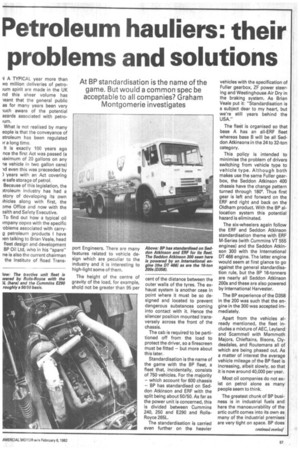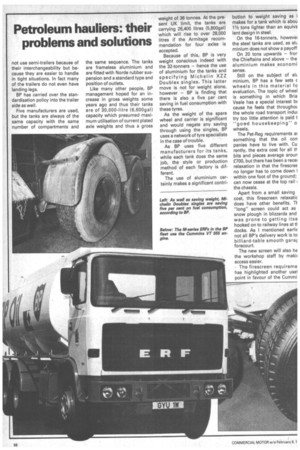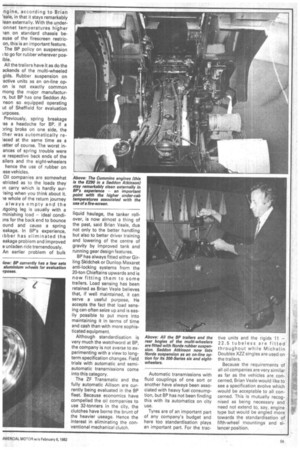Petroleum hauliers: their problems and solutions
Page 53

Page 54

Page 55

If you've noticed an error in this article please click here to report it so we can fix it.
At BP standardisation is the name of the game. But would a common spec be acceptable to all companies? Graham Montgomerie investigates
sl A TYPICAL year more than Ivo million deliveries of petro?um spirit are made in the UK nd this sheer volume has leant that the general public as for many years been very iuch aware of the potential azards associated with petrolurn.
What is not realised by many eople is that the conveyance of etroleum has been regulated )r a long time.
It is exactly 100 years ago nce the first Act was passed (a iaximum of 20 gallons on any rie vehicle in two gallon cans) id even this was preceeded by ) years with an Act covering le safe storage of petrol.
Because of this legislation, the Aroleum industry has had a story of developing its own Ihicles along with first, the Dme Office and now with the 9a Ith and Safety Executive.
To find out how a typical oil Impany copes with the specific .oblems associated with carryg petroleum products I have ?en talking to Brian Veale, head fleet design and development BP Oil Ltd, who in his "spare" ne is also the current chairman
the Institute of Road Trans port Engineers. There are many features related to vehicle design which are peculiar to the industry and it is interesting to high-light some of them.
The height of the centre of gravity of the load, for example, shold not be greater than 95 per cent of the distance between the outer walls of the tyres. The exhaust system is another case in point where it must be so designed and located to prevent dangerous substances coming into contact with it. Hence the silencer position mounted transversely across the front of the chassis.
The cab is required to be partitioned off from the load to protect the driver, so a firescreen must be fitted — but more about this later.
Standardisation is the name of the game with the BP fleet, a fleet that, incidentally, consists of 750 vehicles. For the majority — which account for 600 chassis — BP has standardised on Seddon Atkinson and ERF with the split being about 50/50. As far as the power unit is concerned, this is divided between Cummins 240, 250 and E290 and RollsRoyce 265L.
The standardisation is carried even further on the heavier vehicles with the specification of Fuller gearbox, ZF power steering and Westinghouse Air Dry in the braking system. As Brian Veale put it: "Standardisation is a subject dear to my heart, but we're still years behind the USA."
The fleet is organised so that base A has an all-ERF fleet whereas base B will be all Seddon Atkinsons in the 24 to 32-ton category.
This policy is intended to minimise the problem of drivers switching from vehicle type to vehicle type. Although both makes use the same Fuller gearbox, the Seddon Atkinson 400 chassis have the change pattern turned through 180°. Thus first gear is left and forward on the ERF and right and back on the Oldham product. With the BP allocation system this potential hazard is eliminated.
The six-wheelers again follow the ERF and Seddon Atkinson standardisation theme with ERF M-Series (with Cummins VT 555 engines) and the Seddon Atkinson 300 with the International DT 466 engine. The latter engine would seem at first glance to go against the general standardisation rule, but the BP 16-tonners are nearly all Seddon Atkinson 200s and these are also powered by International Harvester.
The BP experience of the D358 in the 200 was such that the engine in the 300 was accepted immediately.
Apart from the vehicles already mentioned, the fleet includes a mixture of AEC, Leyland and Scammell with Mammoth Majors, Chieftains, Bisons, Clydesdales, and Routemans all of which are being phased out. As a matter of interest the average vehicle mileage of the BP fleet is increasing, albeit slowly, so that it is now around 40,000 per year.
Most oil companies do not exist on petrol alone as many people seem to think.
The greatest chunk of BP business is in industrial fuels and here the manoeuvrability of the artic outfit comes into its own as many of the industrial premises are very tight on space. BP does not use semi-trailers because of their interchangeability but because they are easier to handle in tight situations. In fact many of the trailers do not even have landing legs.
BP has carried over the standardisation policy into the trailer side as well.
Five manufacturers are used, but the tanks are always of the same capacity with the same number of compartments and the same sequence. The tanks are frameless aluminium and are fitted with Norde rubber suspension and a standard type and position of outlets.
Like many other people, BP management hoped for an increase in gross weights some years ago and thus their tanks are of 30,000-litre (6,600gal) capacity which presumed maximum utilisation of current plated axle weights and thus a gross weight of 36 tonnes. At the present UK limit, the tanks are carrying 26,400 litres (5,800gal) which will rise to over 28,000 litres if the Armitage recommendation for four axles is accepted.
Because of this, BP is very weight conscious indeed with the 32-tanners — hence the use of aluminium for the tanks and specifying Michelin XZZ Doublex singles. This latter move is not for weight alone, however — BP is finding that there is also a five per cent saving in fuel consumption with these tyres.
As the weight of the spare wheel and carrier is significant and would negate any saving through using the singles, BP uses a network of tyre specialists in the case of trouble.
As BP uses five different manufacturers for its tanks, while each tank does the same job, the style or production method of each factory is different.
The use of aluminium certainly makes a significant contri
bution to weight saving as i makes for a tank which is abou 11/2 tons lighter than an equiva lent design in steel.
On the 16-tonners, howevei the steel tanks are used, as aft minium does not show a payoff
On 20 tons upwards — fror the Chieftains and above — the aluminium makes .economi sense.
Still on the subject of aft minium, BP has a few sets c wheels in this material fo evaluation. The topic of wheel is something in which Bria Veale has a special interest IDE cause he feels that throughoi the whole road transport indu: try too little attention is paid t "goad housekeeping" o wheels.
The Pet-Reg requirements ar something that the oil con panies have to live with. Cu rently, the extra cost for all tlbits and pieces average aroun 000, but there has been a recei relaxation in that the firescre€ no longer has to come down 1 within one foot of the ground; can now cease at the top rail I the chassis.
Apart from a small saving cost, this firescreen relaxatic does have other benefits. TV "long" screen could act as snow plough in blizzards and was prone to getting itse hooked on to railway lines at ti docks. As I mentioned earliE not all BP's delivery work is to billiard-table smooth garac. forecourt.
The new screen will also he the workshop staff by makii access easier.
The firescreen requireme has highlighted another use1 point in favour of the Cummi
ngine, according to Brian 'eale, in that it stays remarkably lean externally. With the undergannet temperatures higher -tan on standard chassis beause of the firescreen restricon, this is an important feature. The BP policy on suspension to go for rubber wherever posible.
All the trailers have it as do the ackends of the multi-wheeled gids. Rubber suspension on active units as an on-line opon is not exactly common mong the major manufacturrs, but BP has one Seddon Atnson so equipped operating ut of Sheffield for evaluation urposes.
Previously, spring breakage as a headache for BP. If a )ring broke on one side, the ther was automatically relaced at the same time as a latter of course. The worst inances of spring trouble were le respective back ends of the ailers and the eight-wheelers hence the use of rubber on ese vehicles.
Oil companies are somewhat ,stricted as to the loads they in carry which is hardly surising when you think about it. le whole of the return journey always empty and the Agoing leg is usually with a minishing load — ideal condims for the back end to bounce ound and cause a spring eakage. In BP's experience, ibber has eliminated the eakage problem and improved e unladen ride tremendously. An earlier problem of bulk
liquid haulage, the tanker rollover, is now almost a thing of the past, said Brian Veale, due not only to the better handling but also to better driver training and lowering of the centre of gravity by improved tank and running gear design features.
BP has always fitted either G irling Skidchek or Dunlop Maxaret anti-locking systems from the 20-ton Chieftains upwards and is now fitting them to some trailers. Load sensing has been retained as Brian Veale believes that, if well maintained, it can serve a useful purpose, He accepts the fact that load sensing can often seize up and is easily possible to put more into maintaining it in terms of time and cash than with more sophisticated equipment.
Although standardisation is very much the watchword at BP, the company is not averse to experimenting with a view to longterm specification changes. Field trials with automatic and semiautomatic transmissions come into this category.
The ZF Transmatic and the fully automatic Allison are currently being evaluated in the BP fleet. Because economics have compelled the oil companies to use 32-tonners in the city, the clutches have borne the brunt of the heavier useage. Hence the interest in eliminating the conventional mechanical clutch. Automatic transmissions with fluid couplings of one sort or another have always been associated with heavy fuel consumption, but BP has not been finding this with its automatics on city use.
Tyres are of an important part of any company's budget and here too standardisation plays an important part. For the trac tive units and the rigids 11 — 22.5 tubeless are fitted throughout while Michelin Doublex XZZ singles are used on the trailers.
Because the requirements of all oil companies are very similar as far as the vehicles are. concerned, Brian Veale would like to see a specification evolve which would be acceptable to all concerned. This is mutually recognised as being necessary and need not extend to, say, engine type but would be angled more towards the standardisation of fifth-wheel mountings and silencer position.


































































